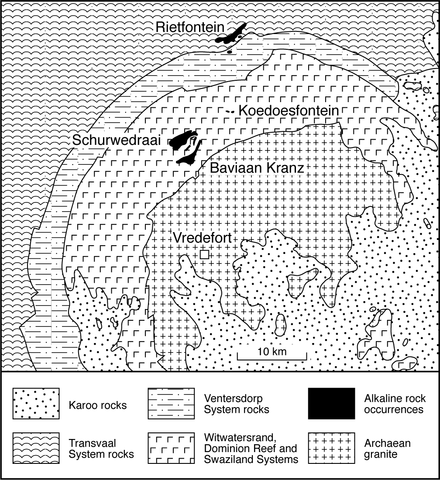stripes
Figs 265 and 266The Rietfontein complex is emplaced into the upper lavas and sedimentary rocks of the Ventersdorp Supergroup and the Chunespoort Group and Black Reef Formation of the Transvaal Sequence. The southern half consists of gabbro, troctolite and wehrlite, the northern of peralkaline granite. The mafic rocks consist of plagioclase, olivine, clinopyroxene, occasionally orthopyroxene, magnetite and, in some rocks, amphibole with apparently no alkaline affinities. The granites intrude the mafic rocks and are medium- to fine-grained with perthite, K-feldspar, Na-feldspar and quartz, the abundance of which, from Bisschoff's (1973) data, indicates that many of these rocks are syenites and quartz syenites rather than granites. Magnesio-arfvedsonite is the typical mafic mineral, sometimes containing diopsidiic cores, but aegirine/aegirine-augite is also present in the more syenitic rocks close to country rock dolomite; biotite is usually present and probable aenigmatite occurs; accessories include magnetite, apatite, titanite and biotite. Three rock analyses are presented by Bisschoff (1973). A 28 m-thick north-south-trending dyke of foyaite cuts across the complex and probably extends for at least 6 km, although outcrops are poor in places (Hall and Molengraaff, 1925). The foyaites consist of orthoclase, some as phenocrysts, nepheline, diopside and aegirine, biotite and accessory apatite. An analysis of this rock is given by Hall and Molengraaff (1925).
BISSCHOFF, A.A. 1973. The petrology of some mafic and peralkaline intrusions in the Vredefort Dome, South Africa. Transactions of the Geological Society of South Africa, 76: 27-52.HALL, A.L. and MOLENGRAAFF, G.A.F. 1925. The Vredefort Mountain Land in the southern Transvaal and the northern Orange Free State. Verhandelingen der Koninklijke Akademie van Wetenschappen te Amsterdam, Sect 2, Deel 24: 1-183.HARGRAVES, R.B. 1970. Paleomagnetic evidence relevant to the origin of the Vredefort Ring. Journal of Geology, 78: 253-63.

